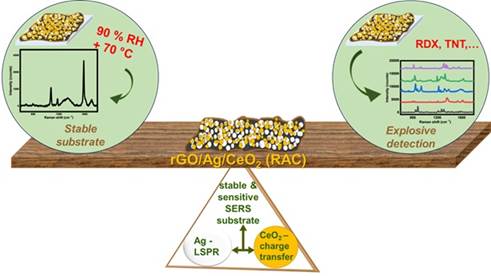Ministry of Science & Technology
Smart Nano-Materials Could Help Detect Explosives With Layers Of Innovation
Posted On:
22 JUL 2025 3:53PM by PIB Delhi
A novel sandwich of smart nano-materials could now help detect harmful chemicals including explosives like TNT and RDX even at trace levels. It holds promise in areas like airport security and environmental pollution monitoring.
In recent years, numerous methods have emerged to detect harmful chemicals that impact our daily lives. Among them, surface-enhanced Raman spectroscopy (SERS) has stood out for its exceptional sensitivity and reliability. SERS works by amplifying the molecular “fingerprint” signals of chemicals, allowing for precise identification even at extremely low concentrations.
Noble metals like gold and silver have traditionally been vital for signal enhancement. However, the high cost of gold and the poor long-term stability of silver and remain significant obstacles to their commercial viability.
Researchers from the Centre for Nano and Soft Matter Sciences (CeNS), Bengaluru, an autonomous institute under the Department of Science and Technology (DST), have developed an innovative multi-layer nanomaterial combining reduced graphene oxide (rGO), silver nanoparticles (Ag) and cerium oxide (CeO₂) on a glass substrate. Each layer contributes a specific function. The team fabricated the composite material using physical vapor deposition techniques, resulting in a uniform and scalable sensing platform.

Fig: The rGO/Ag/CeO2 substrate offers a balanced performance of long-term stability and sensitive explosive detection, driven by the synergistic interplay between Ag-based plasmonic enhancement and CeO2-mediated charge transfer
While silver nanoparticles are excellent at amplifying Raman signals, they are highly prone to oxidation, especially in humid or warm conditions—reducing their effectiveness over time. The coating of a thin layer of cerium oxide brings two key advantages. It enhances charge transfer between the material and the analyte, further boosting the fingerprint Raman signal of the analyte molecule and also acts as a protective barrier, shielding silver from humidity and temperature-induced degradation and ensuring long-term stability.
Environmental chamber tests revealed that the substrate maintained its high performance even under extreme conditions—90% humidity and 70 °C—proving its exceptional stability and reliability.
Meanwhile, the rGO layer plays a crucial role, effectively quenching the overwhelming fluorescence emitted by silver nanoparticles, which would otherwise drown out the distinct Raman fingerprints of the analyte. This clever suppression ensures that the true detection signals shine through with clarity and precision.
The researchers demonstrated the material’s high performance using 4-mercaptobenzoic acid (MBA) as a model analyte, achieving a detection limit as low as 10 nM. More impressively, the substrate demonstrated the ability to detect a wide range of explosives, including TNT and RDX, at nanomolar concentrations, highlighting its broad potential for trace-level contaminant detection.
With its excellent sensitivity, durability, and simple fabrication process, this advanced SERS substrate holds strong promise for real-world applications such as airport security and environmental pollution monitoring where detecting chemicals quickly and accurately can make all the difference.
***
NKR/PSM
(Release ID: 2146787)
Visitor Counter : 104